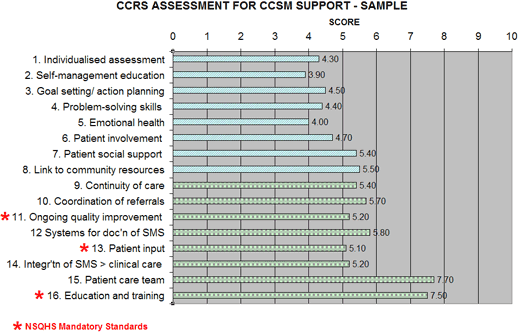Clinical Care Resources and Support (CCRS) Assessment Tool
A key first step towards embedding CCSM support into the workplace can be to conduct a survey using the Clinical Care Resources and Support (CCRS) assessment tool. The CCRS tool can be used:
- to conduct initial and ongoing assessments of the status of CCSM support being delivered by a service area
- to highlight areas for quality improvement
- as evidence to meet National Safety and Quality for Health Service (NSQHS) accreditation criteria.
The CCRS was adapted by the Royal College of Australia and New Zealand Psychiatrists (RANZCP) from the PCRS tool developed by Robert Wood Johnson Foundation Diabetes Initiative, 2006.
The CCRS involves a 5-step quality improvement process.
| Process step |
Description |
| 1. Assessment |
- Conduct an initial assessment of the status of CCSM Support within the service by all staff completing the CCRS survey.
|
| 2. Discussion |
- Compile and discuss assessment findings with staff.
|
| 3. Quality improvement |
- Identify areas for quality improvement.
- Link with accreditation requirements.
|
| 4. Plan of action |
- Decide a tailored plan of action supported by training, tools and resources selected to meet target population and service needs and priorities.
|
| 5. Review |
- Repeat process steps to measure change.
|
CCRS characteristics of CCSM support
The CCRS assesses 16 characteristics of CCSM support:
Section 1 – Patient support
- Individualised assessment of patient self-management needs
- Patient self-management education
- Goal-setting/action planning
- Problem-solving skills
- Emotional health
- Patient involvement in decision-making
- Patient social support
- Linking to community resources
Section 2 – Organisational support
- Continuity of care
- Coordination of referrals (to other care providers following discharge from your service)
- Ongoing quality improvement (QI)*
- System for documentation of self-management support services
- Patient input*
- Integration of self-management support into clinical care
- Patient care team (internal to the practice)
- Physician, team and staff self-management education & training1
Sample Results for a CCRS Assessment
Once the results of the surveys have been compiled, the summary graph below can be produced. Each CCSM Support characteristic can be positioned broadly on a scale:
- inadequate or non-existent activity
- infrequent or inconsistent action; patient interaction is largely passive
- organised, consistent, coordinated action and a team-based approach
- all of previous dot point plus system-wide adoption and integration of self-management support into practice.

In the above graph, activities such as ‘individualised assessment of self-management needs’ and ‘linking to community resources’ are rated as an infrequent or inconsistent actions by the service team and are yet to be embedded into everyday practice and processes.
‘Team work’ scored highly, indicating staff are organised, consistent and coordinated with a team based approach. However, taking this one step further, it also indicates that the team operates within an organisational structure that has not yet fully integrated a collaborative, person-centred approach along clinical pathways and for the consumer journey.
Quality improvement activities can be implemented to address these areas and can be prioritised to align with mandatory accreditation requirements.
Facilities to compile CCRS results have previously been available online or via Survey Monkey.
Links with NSQHS Accreditation
Person-centred care is the first principle of self-management support. A strong link exists between CCSM and National Safety and Quality Health (NSQHS) accreditation standards, in particular ‘Partnering with consumers’ and ‘Provision of care’.
For hospitals, criteria 2.6.1 states:
Clinical leaders, senior managers and the workforce access training on patient-centred care and the engagement of individuals in their care. (i.e. self-management support)1
Resources
Information Sheets
Other resources
1Mandatory National Safety and Quality Health Standards – Standard 2 Partnering with Consumers
Produced by
Chronic Condition Self-Management